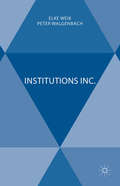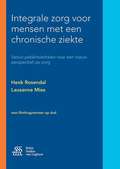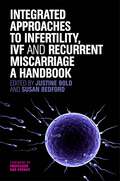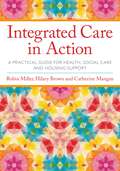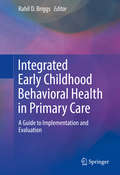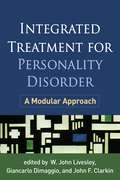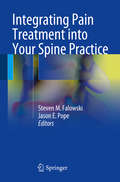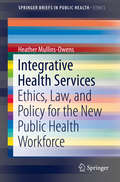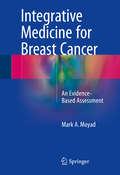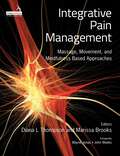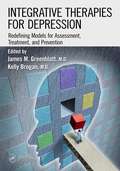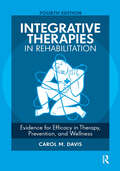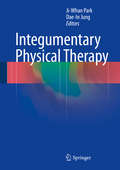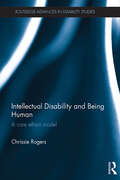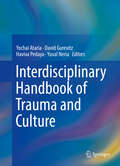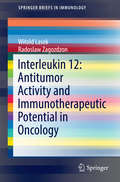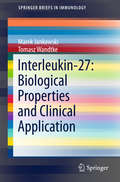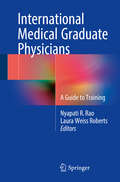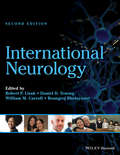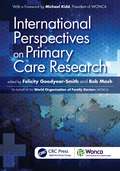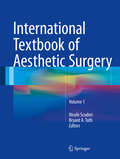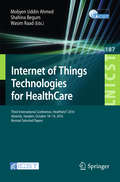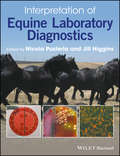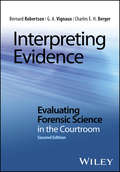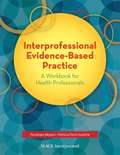- Table View
- List View
Institutions Inc.
by Peter Walgenbach Elke WeikInstitutions Incorporated draws together aspects of human and organizational corporeality and links them to institutions. Throughout European anthropology and culture the body has been conceptualized as the 'dark side' to soul and reason. This book explores the 'dark side' of institutions, their materiality and the bodily involvement of their users, in an environment where perfection is measured in intangible entities, notably reason and will. This innovative collection takes a closer look at the interplay of the symbolic and the material, and the triad of institutions, bodies and corporations. This exciting research examines what the tangible, 'dark side' of institutions means both for those who live in them, and those who study them.
Integrale zorg voor mensen met een chronische ziekte: Vanuit patiëntverhalen naar een nieuw perspectief op de zorg
by Henk Rosendal Lausanne MiesIk heb moeten leren dat ik als patiënt zeggenschap heb over de manier waarop ik behandeld word. Dat het goed is zelf na te denken over mijn wensen en dat ik aangeef hoe ik wil dat zorgverleners met mij omgaan.' Anke de Jong-Koelé Verhalen van mensen met een chronische ziekte staan centraal, zowel in het leer-werkboek als op de bijbehorende dvd. Uit deze verhalen blijkt dat patiënten geen onderscheid maken tussen zorg en welzijn, en ook niet redeneren vanuit een bestaand (zorg)aanbod. Zij willen vooral leren omgaan met de beperkingen die ze ondervinden in hun dagelijks leven. Zorgprofessionals uit de praktijk hebben in focusgroepen op deze verhalen gereflecteerd om de werkelijke problemen en uitdagingen voor eerstelijnszorg boven tafel te krijgen. Vooral de kwaliteit van leven is belangrijk. Iemands medische situatie is daar slechts een onderdeel van. Hoe kan de zorg zich meer richten op de mens en zijn functioneren, en minder op de aandoeningen? Daarvoor moeten professionals een nieuwe werkwijze aanleren: integraal, kritisch en creatief. Dit leer-werkboek bevat veel materiaal om hiermee te oefenen. 'Standaardoplossingen voor mensen met een chronische ziekte werken niet. Dat laat dit boek helder zien. Voor een goede hulpverlening is een open, kritische blik nodig op het leven van iedere patiënt. En vervolgens creativiteit en samenwerking. Een onmisbaar boek in elke opleiding voor zorg en welzijn.' Prof.dr. A.J.P. Schrijvers, hoogleraar Public Health, UMC Utrecht
Integrated Approaches to Infertility, IVF and Recurrent Miscarriage: A Handbook
by Justine Bold Dian Shepperson Mills Kamran Rostami Deborah Cook Irina Szmelskyj Lisa Attfield Natasha Claire Dunn Professor Gab Kovacs Karen Macgillivray-Fallis Karen Veness Clare Casson Susan Bedford Dr Mohammed Rostami-Nejad Louise CarderA comprehensive integrative handbook on fertility treatment, and Assisted Reproduction Techniques (ART), the book is written by specialist contributors for health professionals and Complementary and Alternative Medicine (CAM) practitioners, and for those seriously considering ART themselves. Integrated approaches to infertility offer both a greater awareness and understanding of the combination of factors that can influence the chances of success when undergoing different types of ART. Leading experts review the evidence and discuss the benefits of different approaches to support the physiological and emotional aspects of fertility and fertility treatment. The book covers everything from identifying and treating conditions that may reduce fertility, including immunological abnormalities and specific male and female factors, to how nutrition, acupuncture, reflexology and yoga can support couples going through assisted reproduction, including helping to improve some immunological aspects. There is also a chapter that looks specifically at support for the over 40's.
Integrated Care in Action: A Practical Guide for Health, Social Care and Housing Support
by Robin Miller Hilary Brown Catherine ManganIntegration is now a key expectation within the delivery of health and social care services in the UK and internationally. However, it still remains difficult to achieve and sustain in practice. Based on learning from successful, and unsuccessful, integrated care initiatives, this book is an invaluable guide for those responsible for leading, managing and delivering integrated care across health, social care and housing. Written by an experienced team of researchers who have studied, led and supported integrated care for many years Integrated Care in Practice draws on latest evidence, innovative practice and helpful theory. It provides insights into the common pitfalls that such initiatives can encounter and demonstrates positive approaches to anticipating and responding to such challenges. Throughout, real-case examples are provided, and concepts and models are connected with the realities of day-to-day life for those working within these services. Integrated care is a goal to aspire to - this book helps to explain how we can turn this goal into practical action and positive outcomes.
Integrated Early Childhood Behavioral Health in Primary Care
by Rahil D. BriggsThis book provides a step-by-step guide to integrating early childhood behavioral health care into primary care with hands-on advice for creating, implementing, and evaluating programs. It discusses the unique advantages of pediatric primary care as a setting for mental health services from birth into the early school years, particularly for addressing parent/child stress and trauma issues. Contributors illustrate in depth how bringing behavioral health into pediatric services can engender care that is replicable and sustainable, not only cost-effective but also clinically effective. Guidelines and case examples from frontline practitioners highlight typical challenges and workable recommendations. Among the featured topics: * The fit between early intervention programs and primary care. * Staffing, workforce development, and funding issues. * On-the-job teamwork concerns, from time constraints to continuity of care. * Culturally competent care geared toward key child care issues. * Intervening with parents of young children in the integrated pediatric setting. Integrated Early Childhood Behavioral Health in Primary Care is an essential resource for clinicians/practitioners, graduate students, and researchers in child and school psychology, pediatrics, and social work.
Integrated Treatment for Personality Disorder
by W. John Livesley John F. Clarkin Giancarlo DimaggioRather than arguing for one best approach for treating personality disorder, this pragmatic book emphasizes the benefits of weaving together multiple well-established intervention strategies to meet each patient's needs. A framework is provided for constructing a comprehensive case formulation, planning treatment, and developing a strong therapeutic alliance. The clinician is guided to utilize techniques from all major therapeutic orientations to address transdiagnostic personality symptoms and problems involving emotion regulation, interpersonal functioning, and self and identity. Showing how to pick and choose from "what works" in a thoughtful, coordinated fashion, the book features rich clinical illustrations, including a chapter-length case example.
Integrating Pain Treatment into Your Spine Practice
by Steven M. Falowski Jason E. PopeThis book fills the gap in knowledge and patient care by showing spine surgeons how to integrate pain management techniques into their practice. The first of its kind, Integrating Pain Treatment into Your Spine Practice is in tune with current efforts by major neurosurgical and neuromodulation societies and leading manufacturers of neuromodulation equipment to educate spine surgeons on the management of their patients' post-surgical pain. Designed as an all-in-one volume, this book explains how to identify candidates for pain treatment and when to refer them to specialists. It also presents "how-to" clinical information on approaches to managing pain, from the medical to the interventional and provides practical business guidance on coding and reinforcement.
Integrative Health Services
by Heather Mullins-OwensThis readable overview offers a public health framework for integrating medical and alternative care to improve health outcomes in patients with chronic illnesses. It details the promise, potential, and challenges of holistic services as patients seek diverse treatment options and health care systems address the demand for more affordable, accessible, and effective care. The book's integrative model describes the process in theory and practice, from cost and reimbursement issues and turf wars between providers to expanding on traditional concepts of illness and wellness. Learning objectives, case studies, discussion questions, and other helpful features make this a vital student text. The book's concentrated coverage: Introduces concepts of integrative health services. Applies integrative health concepts to public health areas, e. g. , prevention. Contrasts integrative models of health with the traditional biomedical model. Outlines the scope of integrative health practice. Reviews implications for the public health workforce. Integrative Health Services benefits public health students, pre-med students, and those with an interest in health policy and health trends. Additionally, public health educators, practitioners, and scholars who may not be familiar with integrative health services and conflicts related to their increased use in health care will find it a helpful tool to quickly bring them up to date
Integrative Medicine for Breast Cancer
by Mark A. MoyadThis book is designed to capture and clinically review the comprehensive database of clinical research articles that support and do not support the utilization of a variety of dietary supplements and other complementary medicines that physicians are exposed to in their daily practice. The growing list of CAM products that could interfere with surgery (anesthesia, bleeding, outcomes. . . ) and/or conventional medicines is very large and is provided in each section of the book. Additionally, the list of dietary supplements that could be utilized to improve quality of life for breast cancer patients is also emphasized. The various sub-specialty groups in breast are adequately represented, which allows for a physician to rapidly and thoroughly investigate their topic of interest regardless of whether the topic is prevention, treatment, or a specific side effect of treatment. The practical nature of Integrative Medicine for Breast Cancer: An Evidence-Based Assessment cannot be overstated. Chapters include a general overview of the CAM agent, whether or not it has data in medicine and oncology, and a list of potential drug interactions and specific clinical scenarios where it can be utilized or discouraged in the specialty. Thus, this book will become the gold standard evidence based text for use in teaching, not only for the students interested in oncology and breast cancer, but for all current oncology health providers.
Integrative Pain Management
by Diana L. Thompson Marissa BrooksThis book provides an overview of pain mechanisms as currently understood, and details a variety of approaches to pain management used across a wide range of complementary disciplines. A final chapter integrates these body-based and mind-body approaches, and helps the clinician offer the most effective care for the patient.The first part of the book discusses pain symptoms and the ways in which pain is experienced by individual patients. This section deals with the anatomy and pathology of pain, and describes present views of what causes pain to occur and persist. Integrative care concepts are presented, emphasizing multi-disciplinary approaches to addressing pain.In the second part, expert contributors describe therapeutic approaches to addressing pain conditions and implementing self-care management options, specific to the various disciplines. When available, research supporting the evidence for these interventions is incorporated.In the last chapter, the editors model various care pathways based on these approaches to assist healthcare practitioners in deciding how to effectively co-manage pain, including guidance on when and where to refer.
Integrative Therapies for Depression: Redefining Models for Assessment, Treatment and Prevention
by James M. Greenblatt Kelly BroganIntegrative Therapies for Depression: Redefining Models for Assessment, Treatment and Prevention summarizes emerging theories and research findings on various nonpharmaceutical therapies to treat mood disorders.Supported by the review of nearly 3000 scientific studies, the book describes the concepts of inflammation, genetics, hormonal imbalance, g
Integrative Therapies in Rehabilitation: Evidence for Efficacy in Therapy, Prevention, and Wellness
by Carol M. DavisFor more than 20 years, Integrative Therapies in Rehabilitation continues to be a most researched resource on complementary and alternative therapies in rehabilitation. This renowned text, now in its Fourth Edition, relates the updated scientific evidence and the clinical efficacy of integrating what have now become well known complementary and alternative therapies in rehabilitation to successfully improve patient outcomes. This text has been developed to accompany university courses in complementary and alternative therapies, as a reference manual for clinical practices, and as a resource for those interested in the science behind holistic therapies. Holistic therapies are those therapies not commonly found in allopathic medicine that are intended to stimulate a therapeutic response from both the body – neuromusculoskeletal and cardiopulmonary systems – and the mind. Integrative Therapies in Rehabilitation, Fourth Edition by Dr. Carol M. Davis is particularly designed for those health professionals who want to understand the scientific foundation and peer reviewed research supporting complementary and alternative therapies. The Fourth Edition is divided into two parts. The beginning chapters describe the latest cellular biology science and explain the theories put forth on the overall mechanisms of action of the effect of these various therapies on the soft tissue, fascia and nervous systems. The first part also chronicles the advancement of scientific research in the various therapies since the 1980’s to explain, in cellular physiology terms, the outcomes observed by using a number of holistic therapies. The second part presents various therapies commonly integrated with allopathic therapies in rehabilitation – body work therapies, mind/body therapies, and energy work therapies. The text describes each therapy with a history, cellular mechanism of action, and an up-dated reference section of the evidence of efficacy for the therapy as reported in the literature, often concluding with a case example.Integrative Therapies in Rehabilitation, Fourth Edition will be the go-to resource for health professionals to understand the scientific evidence and efficacy of complementary and alternative therapies for rehabilitation and improving patient outcomes.
Integumentary Physical Therapy
by Ji-Whan Park Dae-In JungThis book is a practical guide to safe and effective physical therapy methods that can be applied in patients with diverse skin ailments, including scars, decubitus ulcers, burns, frostbite, photosensitivity disorders, inflammatory skin disease, skin cancers, obesity-related conditions, psoriasis, herpes zoster, tineapedis, and vitiligo. For each condition, physical therapy interventions- therapeutic exercises, manual physical therapies, and therapeutic modalities employed in rehabilitation- are described in detail. In addition, information is provided on symptoms and complications, examination and evaluation, medical interventions, and prevention and management methods. In the case of obesity-related skin problems, management is discussed from the point of view of Eastern as well as Western medicine. The text is complemented by more than 300 color photographs and illustrations. Integumentary Physical Therapy will help the reader to obtain optimal therapeutic results when treating patients with skin ailments. It will be of value for both practicing physical therapists and students in physical therapy.
Intellectual Disability and Being Human: A Care Ethics Model (Routledge Advances in Disability Studies)
by Chrissie RogersIntellectual disability is often overlooked within mainstream disability studies, and theories developed about disability and physical impairment may not always be appropriate when thinking about intellectual (or learning) disability. This pioneering book, in considering intellectually disabled people's lives, sets out a care ethics model of disability that outlines the emotional caring sphere, where love and care are psycho-socially questioned, the practical caring sphere, where day-to-day care is carried out, and the socio-political caring sphere, where social intolerance and aversion to difficult differences are addressed. It does so by discussing issue-based everyday life, such as family, relationships, media representations and education, in an evocative and creative manner. This book draws from an understanding of how intellectual disability is represented in all forms of media, a feminist ethics of care, and capabilities, as well as other theories, to provide a critique and alternative to the social model of disability as well as illuminate care-less spaces that inhabit all the caring spheres. The first two chapters of the book provide an overview of intellectual disability, the debates surrounding disability, and outline the model. Having begun to develop an innovative theoretical framework for understanding intellectual disability and being human, the book then moves onto empirical and narrative driven issue-based chapters. The following chapters build on the emergent framework and discuss the application of particular theories in three different substantive areas: education, mothering and sexual politics. The concluding remarks draw together the common themes across the applied chapters and link them to the overarching theoretical framework. An important read for all those studying and researching intellectual or learning disability, this book will be an essential resource in sociology, philosophy, criminology (law), social work, education and nursing in particular.
Interdisciplinary Handbook of Trauma and Culture
by Yuval Neria Yochai Ataria David Gurevitz Haviva PedayaThis lofty volume analyzes a circular cultural relationship: not only how trauma is reflected in cultural processes and products, but also how trauma itself acts as a critical shaper of literature, the visual and performing arts, architecture, and religion and mythmaking. The political power of trauma is seen through US, Israeli, and Japanese art forms as they reflect varied roles of perpetrator, victim, and witness. Traumatic complexities are traced from spirituality to movement, philosophy to trauma theory. And essays on authors such as Kafka, Plath, and Cormac McCarthy examine how narrative can blur the boundaries of personal and collective experience. Among the topics covered: Television: a traumatic culture. From Hiroshima to Fukushima: comics and animation as subversive agents of memory in Japan. The death of the witness in the era of testimony: Primo Levi and Georges Perec. Sigmund Freud's Moses and Monotheism and the possibility of writing a traumatic history of religion. Placing collective trauma within its social context: the case of the 9/11 attacks. Killing the killer: rampage and gun rights as a syndrome. This volume appeals to multiple readerships including researchers and clinicians, sociologists, anthropologists, historians, and media researchers.
Interleukin 12: Antitumor Activity and Immunotherapeutic Potential in Oncology
by Witold Lasek Radoslaw ZagozdzonThis book discusses the immunotherapeutic potential of Interleukin 12 in the context of clinical oncology, as well as antitumor effects confirmed in preclinical studies and clinical trials in cancer immunotherapy. Due to its ability to activate both innate (NK cells) and adaptive (cytotoxic T lymphocytes) immunities, Interleukin 12 (IL-12) has been regarded as a promising candidate for tumor immunotherapy. However, despite the encouraging results in animal models, only very modest antitumor effects have been confirmed in early clinical trials. Recently, several clinical studies have been initiated in which IL-12 was applied as an adjuvant in cancer vaccines, in gene therapy including locoregional injections of IL-12 plasmid, and in the form of tumor-targeting immunocytokines (IL-12 fused to monoclonal antibodies).
Interleukin-27: Biological Properties and Clinical Application
by Marek Jankowski Tomasz WandtkeThis volume focuses on various aspects of interleukin-27 (IL-27), especially its potential for clinical applications. The authors discuss the downstream signaling from the IL-27 receptor and its molecular targets in immune cells including Th1, Th2, Th17, Treg, Tr1, Tfh, B cells, DCs and macrophages. The inhibition of Th17 cells by IL-27 is vital for the maintenance of the feto-maternal tolerance and the prevention of lupus, multiple sclerosis, autoimmune uveitis, immune thrombocytopenia and atherosclerosis. However, the same inhibitory capabilities compromise the immune response to bacterial pathogens, and IL-27 is a pathogenic factor in sepsis and tuberculosis. Also covered are the conflicting reports on the role of IL-27 in rheumatoid arthritis, the effect of IL-27 on epithelia, which seems to play a role in asthma, psoriasis and inflammatory bowel diseases, and the direct cytotoxic and anti-vascular effects of IL-27, which make it a promising agent for the treatment of cancer. Accordingly, this volume will be of interest to researchers and clinicians alike.
International Medical Graduate Physicians
by Laura Weiss Roberts Nyapati R. RaoMany thousands of international graduate physicians from diverse medical specialties serve the health care needs of the United States, and one-in-four psychiatry residents are international medical graduates. International Medical Graduate Physicians: A Guide to Training was created by prominent leaders in academic psychiatry to support the success of these international medical graduate physicians as they complete their clinical training and enter the physician workforce in this country. This insightful title has been developed as a valuable resource, filled with key information and personal narratives, to foster optimal wellbeing and decisionmaking of IMG physicians as they navigate their careers. The text is thorough in scope and replete with perspectives, reflections, and tailored guidance for the reader. Many of the chapters are based on the direct and diverse life experiences of the authors. A unique and thoughtful contribution to the literature, this Guide will be of great value to international physicians and to their teachers and supervisors in psychiatry as well as other specialties of medicine.
International Neurology
by Roongroj Bhidayasiri William M. Carroll Robert P. Lisak Daniel D. TruongThis unique textbook deals with the variations in the causes, presentations and treatment of neurological disease throughout human populations. International Neurology is an indispensable guide to the full range of neurological conditions you will see in your ever-changing patient population. Comprehensive coverage of neurological diseases and disorders with a clinical approach to diagnosis, treatment and management Truly international authorship distils expert knowledge from around the world Succinct, bite-sized, templated chapters allow for rapid clinical referral Further reading recommendations for each chapter guide readers requiring more depth of information Endorsed by the World Federation of Neurology
International Perspectives on Primary Care Research (WONCA Family Medicine)
by Felicity Goodyear-Smith Bob MashInternational Perspectives on Primary Care Research examines how the evidence base from primary care research can strengthen health care services and delivery, tackle the growing burden of disease, improve quality and safety, and increase a person-centred focus to health care. <P><P>Demonstrating the inter-professional nature of the discipline, the book also features a section on cross-nation organisations and primary care networks supporting research. National perspectives are offered from researchers in 20 countries that form part of the World Organization of Family Doctors, providing case histories from research-rich to resource-poor nations that illustrate the range of research development and capacity building. <P><P>This book argues the importance of primary care research, especially to policy makers, decision makers and funders in informing best practice, training primary health care providers and achieving equitable distribution of care.
International Textbook of Aesthetic Surgery
by Nicolò Scuderi Bryant A. TothThis two-volume textbook - the result of wide-ranging collaboration among renowned experts in aesthetic surgery from the Americas and Europe - presents state of the art concepts and techniques from across the entire spectrum of cosmetic surgery. It opens with some of the last writings of two of the giants in the discipline, Fernando Ortiz Monasterio and Daniel Marchac, whose contributions set the tone and standard for the rest of the book. In all, there are ten sections covering every aspect of plastic surgery. A very wide range of surgical procedures that can be utilized by the plastic surgeon in training as well as by the established plastic surgeon are described in detail, and in the case of the face, nonsurgical treatments are also fully considered. Further topics include the history of the specialty, legal issues, and anticipated future developments, including regenerative medicine. Numerous beautiful color photographs and skillfully executed illustrations complement the informative text.
Internet of Things Technologies for HealthCare
by Mobyen Uddin Ahmed Shahina Begum Wasim RaadThis book constitutes the proceedings of the Third International Conference on Internet of Things (IoT) Technologies for HealthCare, HealthyIoT 2016, held in V#65533;ster#65533;s, Sweden, October 18-19, 2016. The conference also included the First Workshop on Emerging eHealth through Internet of Things (EHIoT 2016). IoT as a set of existing and emerging technologies, notions and services provides many solutions to delivery of electronic healthcare, patient care, and medical data management. The 31 revised full papers presented along with 9 short papers were carefully reviewed and selected from 43 submissions in total. The papers cover topics such as healthcare support for the elderly, real-time monitoring systems, security, safety and communication, smart homes and smart caring environments, intelligent data processing and predictive algorithms in e-Health, emerging eHealth IoT applications, signal processing and analysis, and smartphones as a healthy thing.
Interpretation of Equine Laboratory Diagnostics
by Nicola Pusterla Jill HigginsInterpretation of Equine Laboratory Diagnostics offers a comprehensive approach to equine laboratory diagnostics, including hematology, clinical chemistry, serology, body fluid analysis, microbiology, clinical parasitology, endocrinology, immunology, and molecular diagnostics. Offers a practical resource for the accurate interpretation of laboratory results, with examples showing real-world applications Covers hematology, clinical chemistry, serology, body fluid analysis, microbiology, clinical parasitology, endocrinology, immunology, and molecular diagnostics Introduces the underlying principles of laboratory diagnostics Provides clinically oriented guidance on performing and interpreting laboratory tests Presents a complete reference to establish and new diagnostic procedures Offers a practical resource for the accurate interpretation of laboratory results, with examples showing real-world applications Covers hematology, clinical chemistry, serology, body fluid analysis, microbiology, clinical parasitology, endocrinology, immunology, and molecular diagnostics Introduces the underlying principles of laboratory diagnostics Provides clinically oriented guidance on performing and interpreting laboratory tests Presents a complete reference to established and new diagnostic procedures
Interpreting Evidence: Evaluating Forensic Science in the Courtroom
by Bernard Robertson G. A. Vignaux Charles E. BergerThis book explains the correct logical approach to analysis of forensic scientific evidence. The focus is on general methods of analysis applicable to all forms of evidence. It starts by explaining the general principles and then applies them to issues in DNA and other important forms of scientific evidence as examples. Like the first edition, the book analyses real legal cases and judgments rather than hypothetical examples and shows how the problems perceived in those cases would have been solved by a correct logical approach. The book is written to be understood both by forensic scientists preparing their evidence and by lawyers and judges who have to deal with it. The analysis is tied back both to basic scientific principles and to the principles of the law of evidence. This book will also be essential reading for law students taking evidence or forensic science papers and science students studying the application of their scientific specialisation to forensic questions.
Interprofessional Evidence-Based Practice: A Workbook for Health Professionals
by Penelope A. Moyers Patricia L. Finch-GuthrieInterprofessional Evidence-Based Practice: A Workbook for Health Professionals promotes active, team learning of interprofessional evidence-based practice (EBP). The book provides detail for developing and launching an Interprofessional Evidence-Based Practice program that goes beyond the evidence process to include implementation science to support practice change. Approaches for developing partnerships for supporting this type of program between universities and health care institutions are contained within, including sample partnership agreements and resource-sharing strategies. Each chapter includes performance objectives, key words, checklists, and materials and resources that an interprofessional team can use.
